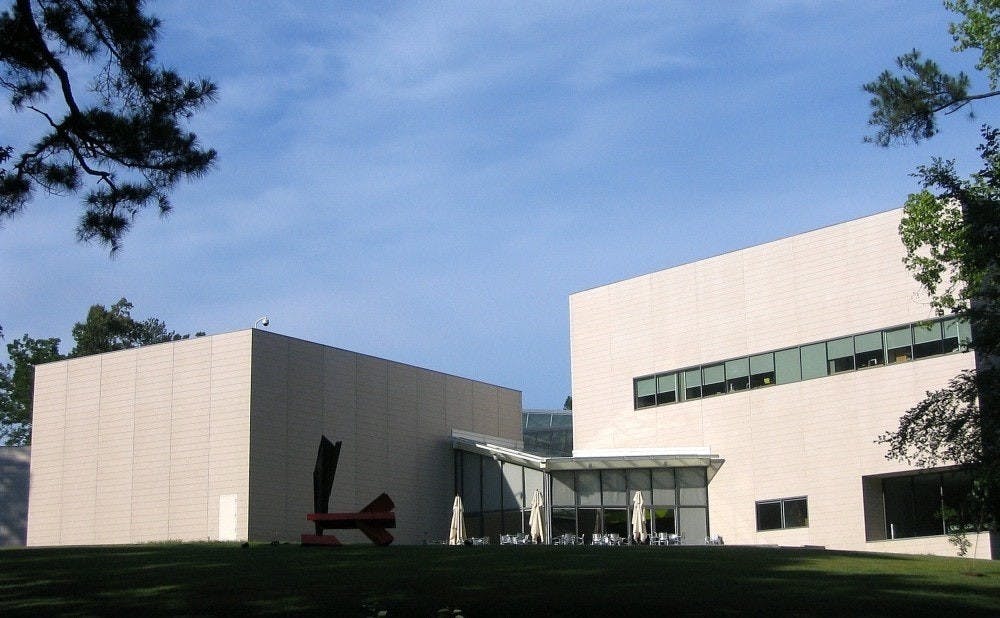On Saturday, Duke students, faculty and members of the Durham community gathered at the Nasher Museum of Art to hear Amy Sherald, who painted the official portrait of the former First Lady for the National Portrait Gallery, deliver the annual Rothschild Lecture.
In a short 30-minute lecture, Sherald, who was born in Columbus, Georgia but now lives in Baltimore, spoke about her notable paintings of African-American subjects. Up until Sherald unveiled the portrait of the first black First Lady of the United States, she had existed relatively under the radar. However, after the reveal of the Michelle Obama portrait, Sherald has been thrust into the spotlight: There’s a high demand for her work and she now has gallery representation.
Although it is easy to get caught up in the noise about Sherald’s Michelle Obama portrait, Sherald has been active for a long time. In 1997, she received her bachelor’s degree in painting from Clark-Atlanta University and in 2004, her MFA in painting from the Maryland Institute College of Art. She was a Spelman College international artist-in-residence in Portobelo, Panama in 1997. In 2016, Sherald was the first woman to win the Outwin Boochever Portrait Competition grand prize.
Sherald’s work has always been concerned with demonstrating how black people show up and exist in the everyday. Through her portraits, she explores the ways that identity interacts with politics, society and culture. For Sherald, growing up in Columbus, Georgia and being one of a few black students at her predominantly white private school and the years she spent dealing with race and identity in the American South was a major influence on her art. Starting out, much of Sherald’s work had an autobiographical focus. She soon turned her attention to producing art that offered a critical view of African-American cultural, social and political history, and the representation of the African-American body in art. In particular, she is known for using a grayscale to paint her subject’s skin tones as a meditation and challenge to the concept of color as race.
“[When I started using the grayscale] for the skin, I still hadn’t quite figured out why,” Sherald said during the lecture. "But, in hindsight, I realized that it was because I knew I wanted to make work that represented black people, but I didn’t want the conversation around the images to be marginalized, and there was a fear of that.”
Much of Sherald’s work stems from turning photographs of ordinary black people into paintings. During her talk, she said she believed that photography was one of the tools available to help humanize black people.
She shared a quote from American abolitionist, Frederick Douglass, who escaped from slavery in Maryland: “Photography dignified the poorest of the poor; it was a potent equalizer.” And that same sentiment can be applied to Sherald’s paintings, as she works to humanize the black male and the black female body, in spite of racist, sexist and classist oppression.
The Nasher recently acquired one of Amy Sherald’s portraits, “Light is easy to love (2017).” In the painting is a young black girl, in a blue sweater patterned with cherries, and white pants. Her gaze is fixed on exactly what is in front of her. She looks confident and powerful. Her hair is a thick, glorious afro. The painting is a dignified version of young black womanhood, and speaks to the relevance of Sherald’s work, for creating images of black people that go beyond pain and suffering and articulate pride and victory. As a black woman, I know how rare it is to see work that represents the wholeness and the sanctity of black womanhood. As Sherald notes in her talk, she wants to make sure that “everybody has a mirror.”
After the talk ended, I asked Sherald what she hopes her work will achieve. Her answer is simple: “I want people to see the beauty in blackness, and I want them to internalize it.”
Get The Chronicle straight to your inbox
Sign up for our weekly newsletter. Cancel at any time.

